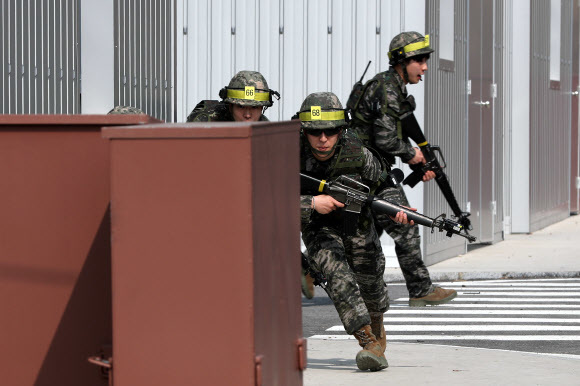 |
|
Soldiers in the South Korean Reserve Forces conduct an urban warfare exercise at a training center in Namyangju, Gyeonggi Province, on Mar. 4, 2019. (Yonhap News)
|
Scale of US troops participating has yet to be disclosed
“Dong Maeng,” meaning “alliance,” the new command post exercise developed by South Korean and US defense authorities to replace Key Resolve following the decision to halt the Key Resolve and Foal Eagle joint exercises, was launched on Mar. 4. Continuing through Mar. 12, the exercise was dubbed “19-1 Dong Maeng,” indicating that it is the first joint exercise of the year. Conducted in the form of a computer simulation, the Dong Maeng exercise involves the Ministry of National Defense (MND), Joint Chiefs of Staff, and Army, Navy and Air Force operational commands on the South Korean side and the Allied Command, US Forces Korea Command and Pacific Command on the US side. The overall scale has reportedly been reduced, including a shorter exercise duration than Key Resolve and the omission of counterfire exercises from the scenarios. The scale of US troops participating in the exercise was not disclosed. The participants are reportedly to consist largely of USFK troops, with few US reinforcements from overseas. “The exercise will be executed with the aim of positing various foreseeable threats and maintaining a comprehensive military readiness posture,” said a South Korean military official. “The scale of the exercises was decided through discussions between South Korea and the US in consideration of the preservation of an allied readiness posture and the current security situation, among other factors,” the official added. The MND said the adjustments to the joint exercises would not cause any issues regarding the combined readiness posture. Responding in a regular briefing on Mar. 4 to comments about the reduced duration of the Dong Maeng exercise compared to the Key Resolve exercise it replaces, MND Spokesperson Choi Hyun-soo said, “Since the training and exercises we conduct will proceed without any issues during that period, there is no problem in terms of achieving the practical aim.” Commenting on the plan to discontinue Foal Eagle and hold year-round exercises chiefly at the battalion level, Choi stressed, “There will be no issue with maintaining a practical combined readiness posture using the newly adjusted field maneuver approach.” South Korea and the US are to individually stage exercises at the regiment level and higher following Foal Eagle’s discontinuation, sources reported. Accordingly, the Ssang Yong exercise, which had been held each year in early April to develop the Combined Forces’ landing capabilities, appears set to take place this year as an independent exercise by the South Korean military without the participation of US troops or equipment. “If combined exercises are deemed necessary over the course of independent exercises at the regiment level and up, they can be supplemented with tactical discussion or operation concept rehearsals,” a senior military official said. Changes are also predicted for the joint Ulchi-Freedom Guardian exercises, which are scheduled to take place in August. The South Korean government is currently developing plans to combine the Ulchi emergency exercise and the South Korean military’s Taegeuk command post exercise into a “Taegeuk-Ulchi” exercise. For the combined command post exercise Freedom Guardian, it is reportedly considering plans to discontinue it and replace it with new exercises under a different name along the same lines as Key Resolve. By Yoo Kang-moon, senior staff writer Please direct comments or questions to [english@hani.co.kr]






